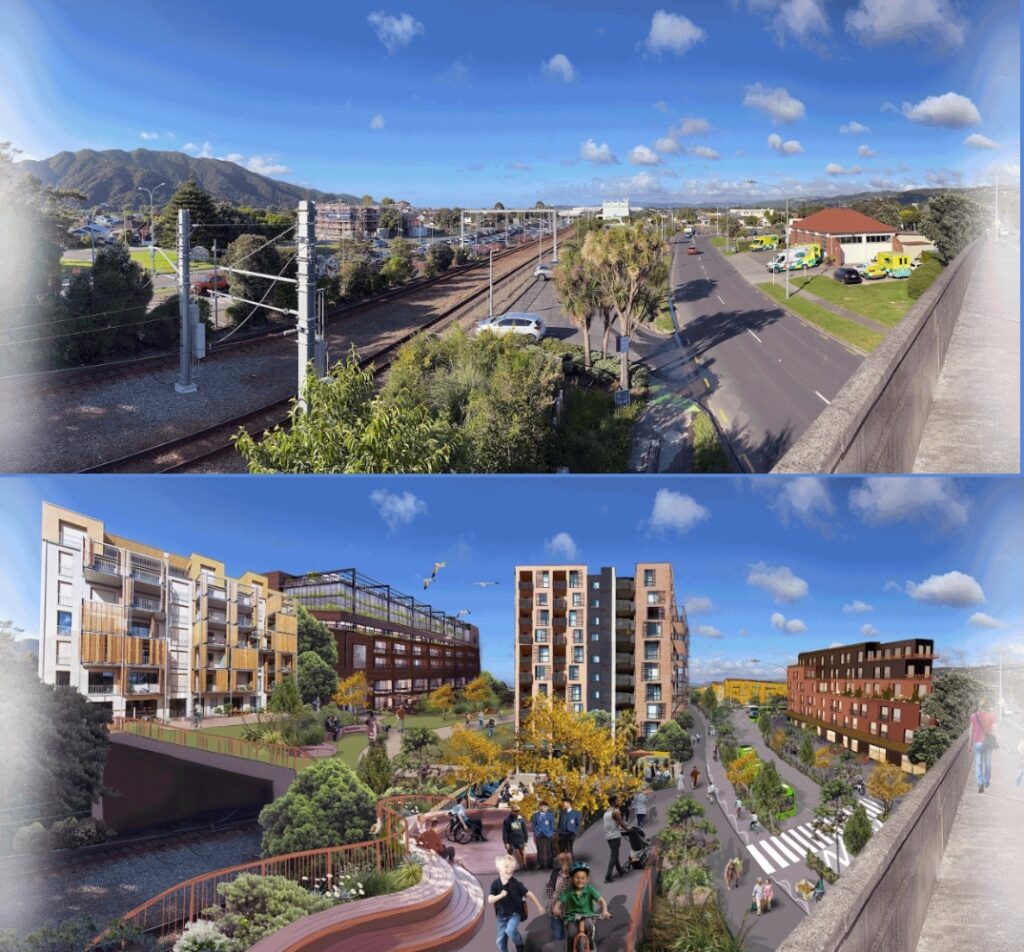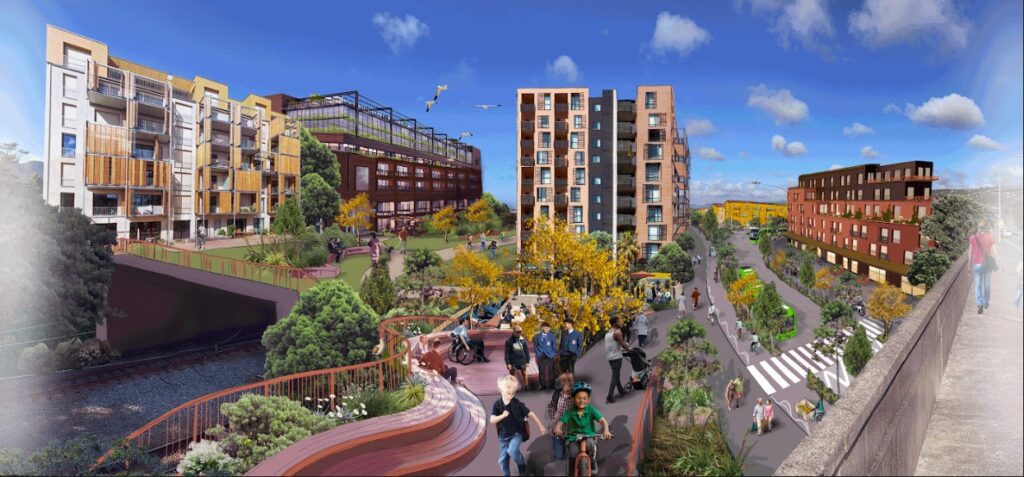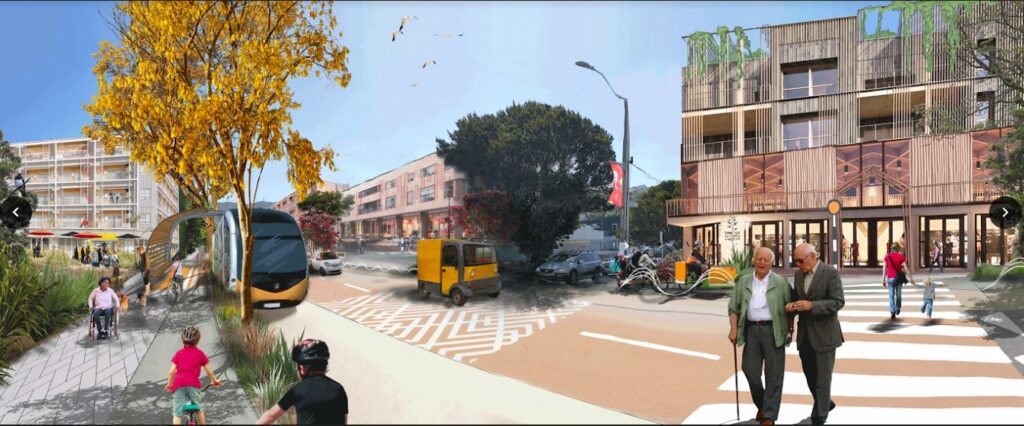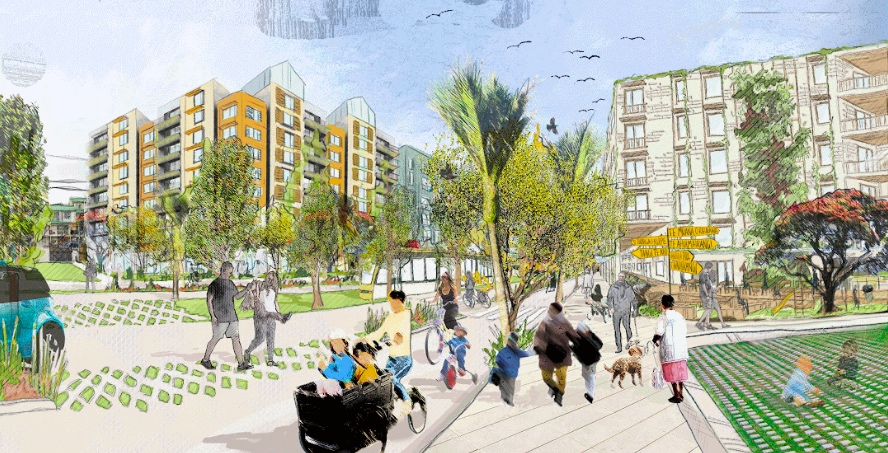
in Waterloo
It's got the basic recipe...
"Tell us about this Waterloo you see..."
As a Quarter-hour Paradise, Waterloo has become a bustling community hub, filled with shops, community services, and delightful green spaces. The neighbourhood’s halves are no longer cut off from each other by the train tracks, instead being connected by inviting shops and entranceways, and a grass podium park with beautiful native plantings. Surrounding the station are modern apartments and townhouses, providing homes for hundreds more households, of all generations. The higher population has supported dozens of new businesses and community groups, and transformed local street life. There are pocket parks, allotments and green roofs in each development, which have brought the neighbourhood flourishing local birdlife, less nuisance flooding, and regular community BBQs. On the streets around, nanas walking and biking with their mokopuna are as common a sight as school students and working-age people. In the evenings, strains of siva, bharatanatyam and hiphop float out over the lively streets. Families picnic and kids play in the green, leafy park as trains pass by beneath and people flow in and out of the station buildings. Into the evenings, locals catch up at the shops and restaurants that line the wide and inviting footpaths of Oxford Terrace. Life in Waterloo? It's rich, and fulfilling and full of opportunities!
- a Waterloo local, 9th August 2040
Waterloo: a basic quarter-hour paradise in action
This is how the essential recipe of the quarter-hour paradise – even just with a very basic lens of “just be buildable” – makes life better in Waterloo.
People-friendly streets

The footpaths are widened to 3.5m for a great walking experience for everyone, and the streets have traffic calming such as raised tables and cobblestones. The section of Oxford Terrace between Knights Rd and the Waterloo Rd bridge is free from private vehicles entirely.
This makes the trip convenient and pleasant for the 3000 people a day who walk, bike, scoot bus, or taxi to Waterloo Station – which has been transformed into a multi-purpose transit hub.
There are frequent and fast trains into Wellington leaving every 10 minutes and cross- platform connections for high-capacity electric buses, taking people to Wainuiomata to the east and Lower Hutt City Centre to the west, on dedicated bus-only lanes.
At the south end by Knights Road there’s an area for quick drop-offs, taxis and car shares, and a buzzing hub for e-scooters, bike parking and a bike-share all run by the Waterloo Bike Box crew.
Running alongside the train station, the heavily-used Beltway shared path , sees hundreds of people biking, scooting and walking to the Lower Hutt city centre, and to the rest of the Hutt valley to the north and south, and to Wellington.
Most people living within 15 minutes of the station don’t bother to own their own car as they only use one occasionally, choosing from one of the local carshare services when they do.
The average carbon footprint for a resident in Waterloo is half what it is in 2022.
Density done well

The new homes are a mix of townhouses and mid-rise apartments, with a wide variety of home sizes from single-person studios to homes for large families, and flexible setups for changing needs. Every development has thoughtful common spaces and services within it for the residents, with inside and outside spaces like gardens encouraging neighbourly relationships and a sense of pride.
The buildings are oriented toward the sun and are built using energy-efficient designs, meaning the average household uses half as much power to stay warm and dry compared to the typical homes in Waterloo in 2022.
Every building is base-isolated for earthquake protection, there are also low-use water fixtures and smart wastewater retention tanks to prevent overloading pipes.
Most are mixed-use developments, with retail units on the ground floor for cafes, locally-owned shops, and community spaces.
The green roofs use captured rain for some water needs, and filter the rest to canopy gardens and native plantings.
There are abundant green spaces and pocket parks with room for children to play, families to picnic, and people to enjoy the fresh air.
Access to all you need
The higher population density makes dozens of new businesses viable, especially nearest to the train station which capture foot traffic of thousands of daily commuters. There are new cafes, eateries, grocery stores, gyms, bookstores, and bike shops. New businesses move in, while old favourites like Roti Bae have expanded and are thriving.
The area doesn’t compete directly with Lower Hutt City as a shopping district, but it is its own neighbourhood economy. There are new daycares and pre-schools catering to the growing community.
The council has purchased retail spaces and turned it into a community centre, where people can access services like the Women’s Centre and MIX, or explore fulfilling new hobbies and make lifelong friends.



Like all the visualisations here, this picture is the most basic recipe applied simply to the site.
It’s beige, unadorned, lacking flavour or local nuance.
The huge missing element: how local people would like to see quarter-hour paradise growing in their neighbourhood.
Let's explore this together!
Over on the Quarter-hour Paradise social media there’s friendly, curious conversation happening.
It’s about how neighbourhoods like Karori can develop their quarter-hour paradise goodness in ways that feel local. In ways that draw out, that build on, that amplify what’s great about the neighbourhood.
It’s a bit of an oasis on social media.
- iI’s a space to bring genuine questions and ideas about what change might mean; about bad and good ways to do intensification, to do street change, and to set up and run our towns.
- There’ll be honest answers, inspiration from our own doorsteps and further afield, and other curious minds from your community – all coming together a spirit of “why not?”, “we got this”, and “yes, and“.
- It’s apolitical (no endorsements or promotions of candidates), and it’s a space for citizen conversation.





